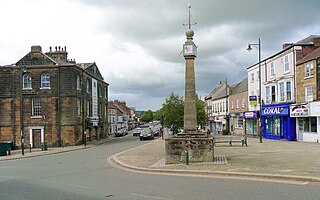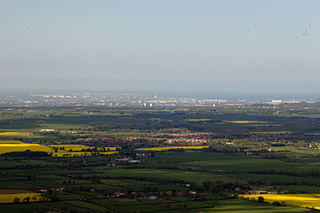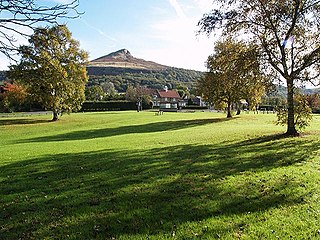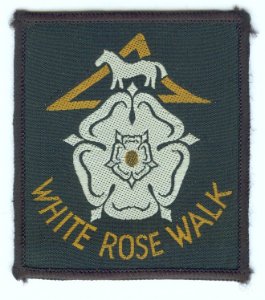
North Yorkshire is a ceremonial county in the Yorkshire and the Humber and North East regions of England. It borders County Durham to the north, the North Sea to the east, the East Riding of Yorkshire to the south-east, South Yorkshire to the south, West Yorkshire to the south-west, and Cumbria and Lancashire to the west. Northallerton is the county town.

Cleveland is a land of hills and dales from the River Tees to Vale of Pickering, England. The name means “cliff-land”.

Guisborough is a market town and civil parish in the borough of Redcar and Cleveland, North Yorkshire, England. It lies north of the North York Moors National Park. Roseberry Topping, midway between the town and Great Ayton, is a landmark in the national park. At the 2011 census, the civil parish with outlying Upleatham, Dunsdale and Newton under Roseberry had a population of 17,777, of which 16,979 were in the town's built-up area. It was governed by an urban district and rural district in the North Riding of Yorkshire.

Eston is an area of Redcar and Cleveland in North Yorkshire, England. The local authority ward covering the area had a population of 7,005 at the 2011 census. It is part of Greater Eston, which includes the outlying settlements of Grangetown, Normanby, South Bank, Teesville and part of Ormesby.

Teesdale is a dale, or valley, in Northern England. The dale is in the River Tees's drainage basin; most water flows stem from or converge into said river, including the Skerne and Leven.

Great Ayton is a village and civil parish in North Yorkshire, England. The River Leven flows through the village, which lies just north of the North York Moors. According to the 2011 Census, the parish has a population of 4,629.

Urra Moor is the highest moor in the North York Moors, North Yorkshire, England. At 1,490 feet (454 m) above sea level it is the highest point in Hambleton District and the North York Moors National Park, and the fourteenth most prominent hill in England. The name is a mix of Old English and Old Norse which means The Dirty Hill. The name of Urra Moor applies to the moor as a whole; the summit itself is known as Round Hill.

Newton under Roseberry is a village in the borough of Redcar and Cleveland and the ceremonial county of North Yorkshire, England. It is on the A173, between Great Ayton and Guisborough and is close to the base of Roseberry Topping.

Nunthorpe is a village and civil parish in the Borough of Middlesbrough in North Yorkshire, England.

The Cleveland Hills are a range of hills on the north-west edge of the North York Moors in North Yorkshire, England, overlooking Cleveland and Teesside. They lie entirely within the boundaries of the North York Moors National Park. Part of the 110-mile (177 km) long Cleveland Way National Trail runs along the hills, and they are also crossed by a section of Wainwright's Coast to Coast Walk. The hills, which rise abruptly from the flat Tees Valley to the north, include distinctive landmarks such as the cone-shaped peak of Roseberry Topping, near the village of Great Ayton – childhood home of Captain James Cook.

The Cleveland Way is a National Trail in the historic area of Cleveland in North Yorkshire, Northern England. It runs 110 miles (177 km) between Helmsley and the Brigg at Filey, skirting the North York Moors National Park.

The White Rose Walk, a 35-mile (56 km) trail located in North Yorkshire, England, was devised in 1968 by the Yorkshire Wayfarers, It starts at the Kilburn White Horse and is completed by touching the trig point on top of Roseberry Topping. The walk whilst recognised by the Long Distance Walkers Association (LDWA) as a long distance walk in itself, mixes and crosses with several other long distance paths including the Cleveland Way, the Coast to Coast Walk, and the Lyke Wake Walk. The route takes in the highest peaks in the area such as Live Moor, Carlton Moor, Sutton Bank, Cold Moor, the Wainstones and Urra Moor. The walk also passes Captain Cooks Monument on Easby Moor.

Rosedale is a valley located almost in the centre of the North York Moors national park in North Yorkshire, England. The nearest town is Kirkbymoorside, some 7 miles (11 km) to the south. Rosedale is surrounded by moorland. To the north-west sits Blakey Ridge at over 1,300 feet (400 m) above sea level. At Dale Head is the source of the River Seven,which flows down the valley to join the River Rye at Little Habton near Malton. At its southern end Rosedale is squeezed between Spaunton Moor and Hartoft Rigg, where the river flows out through Forestry Commission woodland before passing the village of Cropton to reach the plains of the Vale of Pickering.

Eston Nab is a rocky outcrop hill in the town of Eston, Redcar and Cleveland, North Yorkshire, England.
Penhill is a prominent hill, 5.5 miles (9 km) south west of Leyburn, in the Pennines, North Yorkshire, England. It forms a ridge that commands the southern side of Wensleydale and the northern side of Coverdale. Its concave shape was formed during the last ice age, when glaciers carved Wensleydale into a U-shape. The summit plateau has a trig point, small tarns on the peat moor, and, visible from the valley floor, a beacon at its eastern end, part of the large network built to warn of a Spanish invasion.

Birks Fell is a hill in the Yorkshire Dales, near to Hubberholme in North Yorkshire, England. It is classed as a Marilyn. Birks Fell only became an official Marilyn in 2006 as it was resurveyed and discovered to be 610 metres (2,001 ft) and not 608 metres (1,995 ft) as previously thought. Books from the late 19th and early 20th centuries list the hill as being 2,001 feet (610 m) and it is thought that in the conversion to metric, the hill lost some height. This raises it above neighbouring Horse Head Moor, making it the Marilyn in place of Horse Head Moor.

Carlton Bank is a hill in the Cleveland Hills, in north-east England. It is within Carlton Moor in the North York Moors and overlooks the villages of Carlton-in-Cleveland and Faceby. The summit provides extensive views of Teesside including Middlesbrough and Redcar to the north as well as the surrounding moorland. Roseberry Topping can also be clearly seen from the summit in a north-easterly direction. The bank was host to an alum works in the 18th century.
Roseberry Parkway railway station is a proposed railway station which would be between Nunthorpe and Great Ayton railway stations on the Esk Valley Line, in North Yorkshire, England. The station was proposed in August 2019 by a joint project between Redcar & Cleveland and Middlesbrough Councils and the Tees Valley Combined Authority. The project is "aimed at easing road congestion and improving access to East Cleveland".
Cleveland Mountain Rescue Team is one of five search and rescue teams based in the North East region of England. The team is based in the village of Great Ayton in North Yorkshire. They were called out to 61 incidents in 2019, and 58 in 2020.

Roseberry Mine was an ironstone mine in the North Riding of Yorkshire, England, which operated between 1883 and 1924, with a break of 24 years. Both periods of mining used a form of tramway to transport the ironstone out, which connected with the railway line north of Great Ayton railway station. The mine was located on the south side of Roseberry Topping digging into the hillside. Of the three ironstone mines in the Great Ayton area, Roseberry was the largest.



















